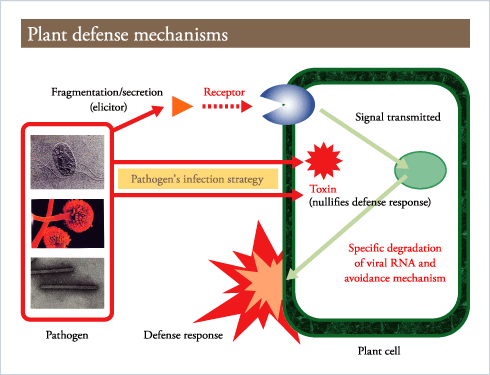

Some people might find it strange to hear that plants are affected by stress. Yet this is true. Plants are affected by climatic change or invasion by pathogens, in other words, abiotic or biotic stress. The more useful question is how plants respond to these forms of stress.
One person who has studied this question extensively is Professor Naoto Shibuya of the Department of Life Sciences in the School of Agriculture.
“Plants have their own unique ways of combating stress,” he explains, “Some have counterattack mechanisms that they deploy after detecting infection by a pathogen. Plants are equipped with an immune system that works at the molecular level. By understanding such mechanisms, we hope to create disease-resistant plant varieties and so help to decrease the loss of crop yields to diseases. This is an important aim when you consider that 14% of terrestrial food crops are lost each year to disease. That’s enough food for a billion people.”
Elucidating Plant Immune Systems
Professor Shibuya’s research group focuses on elucidating the molecular mechanisms involved in plant stress responses and applying this knowledge to agriculture. In fiscal 2008 the Ministry of Education, Culture, Sports, Science and Technology designated this work as part of a Special Grant for Strategic Development of Scientific Research in Private Universities.When fungi, bacteria or other pathogens attempt to invade a plant, the plant initiates various defense responses such as the production of antimicrobial substances. Plants possess highly sensitive detectors for the invasion of such pathogens: for example, they can detect typical cell surface molecules of fungi at a concentration of less than 1 nanogram (a billionth of a gram) per milliliter.
Substances specific to pathogenic microbes such as chitin fragments can trigger defense responses in the plant. Professor Shibuya’s team was the first in the world to discover two new families of receptors that are critical for this defense response.
“We discovered receptors that we call Chitin Elicitor Binding Protein, CEBiP, and Chitin Elicitor Receptor Kinase 1, CERK1,” says Professor Shibuya. “These are molecules sitting in the plant’s plasma membrane that detect chitin oligosaccharides.”
The discovery of these two new receptor types was groundbreaking. The research demonstrated clearly that these membrane receptors not only detect specific chitin fragments, but also send the information inside the cell to trigger gene expression required for defense responses. Professor Shibuya’s team was in fierce competition with overseas universities to make this breakthrough discovery.
Their research did more than shed fresh light on how some plants can resist disease.
For example, it is well known that bacteria of the Rhizobium genus living inside the roots of certain legume varieties can fix nitrogen directly from the air. It has been shown that these legumes have developed a symbiotic relationship with these bacteria by supplying them with nutrients. This symbiosis is what enables such legume varieties to grow in nitrogen-poor soils.
It turns out that the signal molecule that triggers the symbiotic relationships between leguminous plants and Rhizobium bacteria differs only slightly from the chitin fragments capable of triggering the defense response. Actually, the signal molecule for the symbiosis is a group of modified derivatives of chitin oligosaccharides. Thus, only a slight difference in the related signal molecules determines whether the plant tries to exclude the invading microbe as a pathogen or develops a symbiotic relationship with it.
“We still do not understand why this happens,” admits Professor Shibuya. “But if, for example, we could create a variety of rice that would grow symbiotically with Rhizobium, it would greatly reduce the amount of nitrogen fertilizer required to cultivate such rice plants.”

Development of Anti-stress Foods
While elucidating the process by which plants repel pathogenic bacteria, Professor Shibuya’s research has also demonstrated that it may be possible to control interactions between plants and beneficial bacteria such as Rhizobium. In the future it might be possible to develop crops that are disease-resistant and require less chemical fertilizers or pesticides.This research is part of an ongoing project with broader aims. These include studying how plant pathogens suppress the resistance of the plants that they invade, and how to overcome this; studying the mechanisms involved in carbonyl stress in human beings, which is currently in the spotlight due to a possible connection with lifestyle-related diseases such as diabetes; and the development of anti-stress foods and stress diagnostic kits. The university continues to make progress on these research fronts.
Profile
Professor Naoto Shibuya, Department of Life Sciences, School of Agriculture, specializing in plant physiology, functional biochemistryBorn in Tokyo in 1945. Completed Master’s course in the Graduate School of Agriculture, Tokyo University of Education. Worked as a researcher at the Ministry of Agriculture and Forestry’s Food Research Institute (now the National Food Research Institute (NFRI)); a doctoral research fellow in the Department of Biological Chemistry, University of Michigan Medical School; head of the Cell Physiology Laboratory and director of the Department of Biotechnology at the National Institute of Agrobiological Sciences; and the director of the Biopolymer Research Group at the National Institute of Agrobiological Sciences (an independent administrative institution). Has been in his current position since 2002.
Society memberships
International Society for Molecular Plant-Microbe InteractionsAmerican Society of Plant Biologists
Japanese Society of Plant Physiologists
Japanese Biochemical Society
Phytopathological Society of Japan
Japanese Society of Carbohydrate Research
Major academic papers (Original papers)
H. Kaku, Y. Nishizawa, N. Ishii-Minami, C. Akimoto-Tomiyama, N. Dohmae, K. Takio, E. Minami, N. Shibuya (2006) Plant cells recognize chitin fragments for defense signaling through a novel plasma membrane receptor. Proc. Natl. Acad. Sci. USA, 103, 11086-11091.Miya, A., Albert, P., Shinya, T., Desaki, Y., Ichimura, K., Shirasu, K., Narusaka, Y., Kawakami, N., Kaku, H., Shibuya, N. (2007) CERK1, a LysM receptor kinase, is essential for chitin elicitor signaling in Arabidopsis. Proc. Natl. Acad. Sci. USA, 104, 19613-19618.
Reviews
N. Shibuya and E. Minami (2001) Oligosaccharide Signaling for Defense Responses in Plant, Physiol. Mol. Plant Pathol., 59, 223-233.Silipo, G. Erbs, T. Shinya, J. M. Dow, M. Parrilli, R. Lanzetta, N. Shibuya, M. A. Newman, A. Molinaro (2010) Glyco-conjugates as elicitors or suppressors of plant innate immunity. Glycobiology, 20, 406-419.










